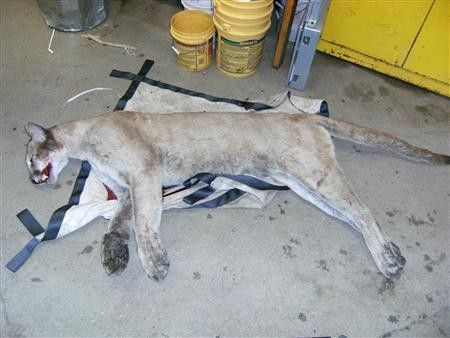Mountain lion killed in Connecticut prowled east from S. Dakota

A mountain lion killed on a Connecticut highway in June was a wild animal from South Dakota that prowled more than 1,500 miles eastward before meeting his death 70 miles from New York City, genetic tests confirmed this week.
The big cat with a long tail and an even longer tale was determined to have travelled through Minnesota and Wisconsin in late 2009 and 2010 before arriving in the posh suburb of Greenwich, Connecticut, according to DNA testing of the animal and his scat.
The cougar was struck and killed on a commuter roadway, the Wilbur Cross Parkway, on June 11.
"I think it's staggering that he was able to go 1,500 miles but also travel through those areas without being detected or killed," said Mark Dowling, a director at the Cougar Network.
"Moving through the Midwest and Northeast, it's a gauntlet of potential detection -- roads, highways, rivers and dogs to get through," he said.
The cross-country trek is one of the longest movements on record for a land mammal and nearly doubles any known distance traveled by a mountain lion, according to Connecticut environmental officials. It's also the first recorded confirmation of a wild mountain lion in Connecticut in more than 100 years, officials said.
Since eastern mountain lions recently were declared extinct, authorities initially thought the cat might have escaped from captivity.
But DNA tests on the 140-pound animal, believed to be two to five years old, matched the genetic structure of the mountain lion population in the Black Hills region of South Dakota, officials said.
Other signs that he was a wild animal included the fact he was not declawed, neutered or implanted with a microchip but did have porcupine quills embedded in his tissues.
Some experts suspect this could be the same animal filmed by a trail camera in Michigan's Upper Peninsula, leading wildlife experts to map its likely path from the U.S. into Ontario Canada, circling the Great Lakes and eventually crossing back into New York and Connecticut.
Young male cougars disperse from where they were born looking for territory and mates, experts said. The cats can easily cover 20 or 30 miles in a day, stopping to hunt and eat along the way.
© Copyright Thomson Reuters 2024. All rights reserved.





















